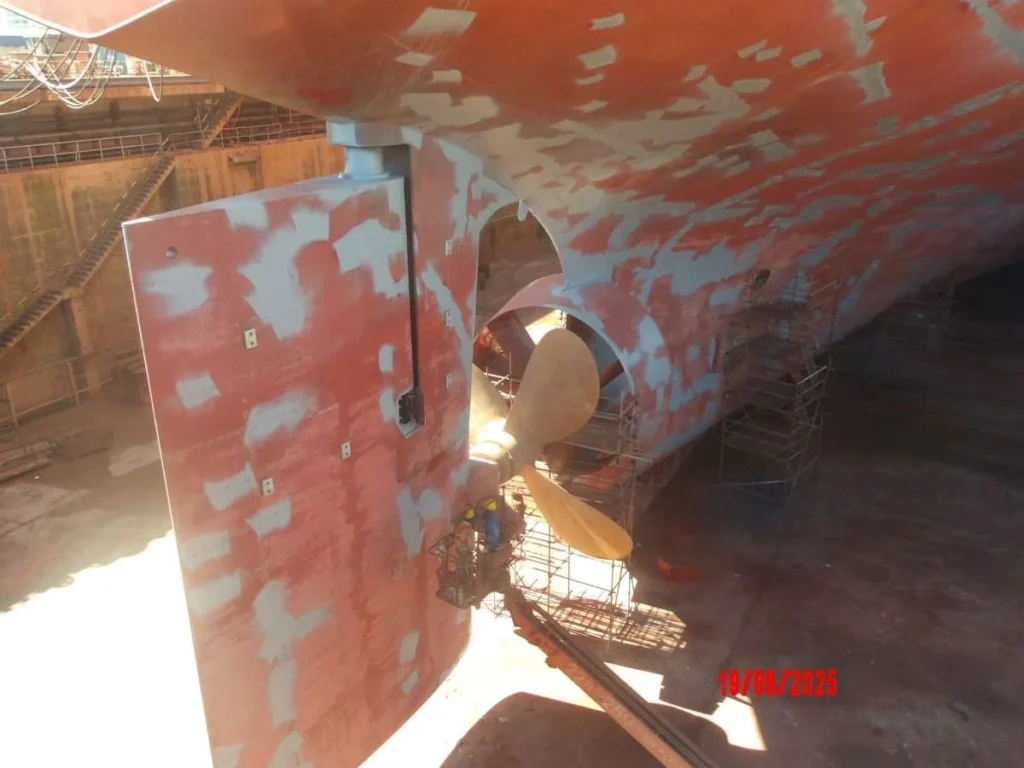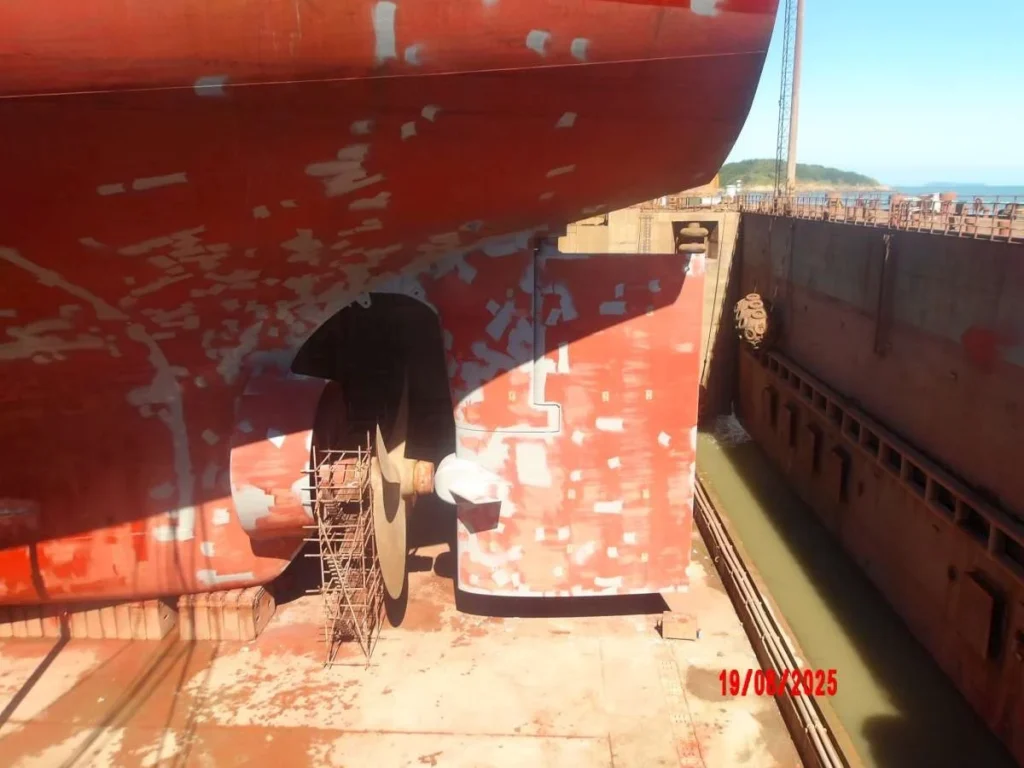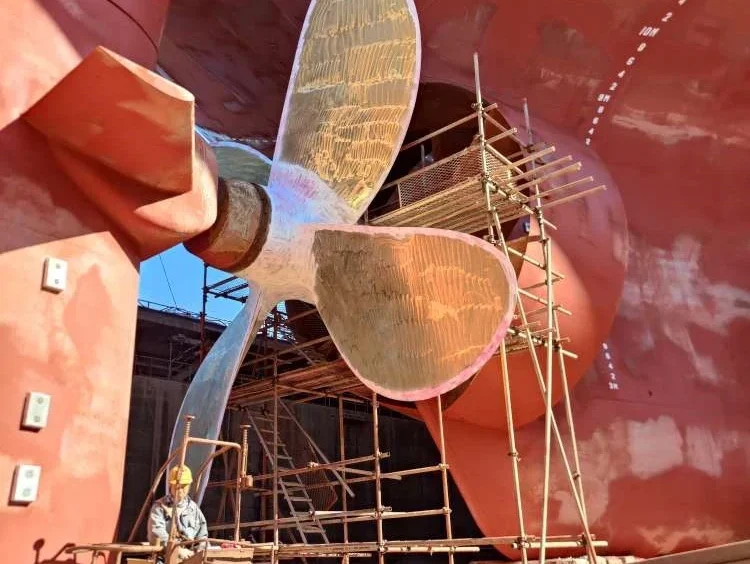Discover the importance of propeller polishing on ships. Learn procedure, benefits, frequency, cost, and how it saves fuel and improves efficiency.
Introduction
The propeller is the uniform of every ship, for it is that article which enables her to make progress through the fluid sea. But here’s something most fresh young cadets and junior officers never realise: the best designed, shiniest propeller doesn’t stay shiny for long.
Propeller fouling, corrosion and roughness are as well among the effect of always sailing in seawater. Within months, the shiny bronze or nickel-aluminium-bronze blades can lose their gleam and end up slimed, barnacled and pitted by small rough patches.
The effect may not be visible from deck, but down in the performance logs, the Chief Engineer will notice a small rise in fuel consumption, and the Master may observe a drop in service speed. A fouled propeller makes the main engine work harder, wastes fuel, and increases CO₂ emissions.
That’s why propeller polishing is one of the most cost-effective maintenance jobs in shipping. In this blog, we’ll break it down in detail — why it’s needed, when it should be done, how it’s carried out, the cost vs. savings, and safety measures — all explained in a simple, human style.
Why Propeller Polishing Matters for Ship Performance
A clean and smooth propeller is like a sharp knife — it does the job with less effort. A fouled propeller, on the other hand, is like a blunt knife — it still works, but requires more force.
Here are the main reasons polishing is critical:
Fuel Efficiency: Studies show that even a lightly fouled propeller can increase fuel consumption by 5–10%. On a VLCC or Capesize bulk carrier, that means several tons of extra fuel daily.
Improved Speed: Ships maintain charter party speed without overloading the engine.
Vibration Reduction: Smooth propellers eliminate cavitation and vibration that transfers to the rest of your boat.
Reduced Emissions: Lower fuel burned = reduced CO₂, NOₓ & SOₓ.
Life of the Propeller: Less wear, pitting and cavitation erosion equals longer service life.
Pro Tip: A single badly fouled propeller can add tens of thousands of dollars to an owner’s cost for extra bunkers on a single voyage.
When Should Propeller Polishing Be Done?
There’s no one-size-fits-all answer, but here’s what most operators follow:
- Every 6-12 months during normal operations.
- During dry dock (as part of hull cleaning, inspections, and maintenance).
- When performance monitoring shows abnormal fuel figures:
- Higher fuel consumption at the same RPM.
- Drop in ship’s speed at constant power.
- Increased shaft torque or vibrations.
Some owners use propeller performance curves (RPM vs. speed at fixed power) to decide when polishing is due. Others follow charterer requirements — oil majors often insist on polishing before voyage commencement.
Methods of Propeller Polishing
- In-Water Propeller Polishing (IWP)
Carried out by certified diving contractors at anchorage or port.
Divers use hydraulic polishing machines fitted with abrasive pads/discs.
Usually performed in graded stages: Coarse → Medium → Fine finish.
Achieves final smoothness of Ra < 0.8 µm (international standard).
Immediate performance improvement without dry docking.
- Dry Dock Propeller Polishing
Done during scheduled dry dockings.
Allows thorough visual inspection and blade repair (if cavitation damage is found).
Propeller can be polished, ground, or even coated with anti-fouling/anti-cavitation paints.
Usually combined with hull blasting and painting.
Step-by-Step Propeller Polishing Procedure (In-Water)
- Preparation
Ship stops engines and secures propeller.
Main engine controls tagged out (LOTO applied).
Diving team gets port and class approval.
- Inspection
Divers inspect, video, and photograph current propeller condition.
Blade surface roughness measured (before values).
- Polishing
Diver uses hydraulic polishing tool, fitted with abrasive discs.
Starts with coarse grit, gradually moves to fine.
Blade polished one by one, from tip to root.
- Final Checks
Blade surface roughness checked (target Ra < 0.8 µm).
After-polishing photos/videos taken.
Report submitted to vessel/owner.
Safety Measures During Propeller Polishing
Main Engine Isolation: Bridge, CCR, and ECR all informed. Propeller tagged “Do Not Operate.”
Diving Safety: Approved dive contractor with standby diver, communication, and decompression arrangements.
Supervision: Master/Chief Engineer monitors from ship’s side.
Emergency Procedures: Agreed signals between dive supervisor and ship.
Pro Tip: Never underestimate risks of diving ops. Even a minor miscommunication can be fatal.
Class and Regulatory Requirements
Diving operations require port permission.
Charterer Demands: Many oil majors and RightShip inspections require proof of recent polishing.
Records: Always keep polishing reports, roughness values, and photographs ready. PSC and vetting inspectors often ask for these.
Cost vs. Savings
Cost of Polishing: Typically USD 3,000 – 8,000 depending on port and vessel size.
Savings: On a Capesize bulk carrier, a clean propeller can save 3–6 tons of fuel daily. At $600/ton, that’s up to $3,600 per day saved.
Payback: Most polishing jobs pay for themselves in 2–4 days of sailing.
FAQs
- How often should a ship’s propeller be polished?
Every 6-12 months, or when performance data shows rising fuel consumption or speed loss.
- What is the cost of in-water propeller polishing?
USD 3,000 – 8,000 depending on location, vessel size, and contractor.
- Does propeller polishing really save fuel?
Yes. A fouled propeller can increase fuel consumption by 5–10%. Polishing usually pays for itself in a few days.
- What is the difference between hull cleaning and propeller polishing?
Hull cleaning reduces resistance from fouling on the ship’s bottom. Propeller polishing improves efficiency of the blades. Both are important, but polishing gives immediate performance improvement.
- Is propeller polishing compulsory?
Not legally, but most charterers and inspection bodies strongly recommend it for efficiency and environmental reasons.
Conclusion
Propeller polishing may look like a small maintenance job, but for a ship operator it’s a big-ticket efficiency booster. A smooth, polished propeller means:
- Lower fuel bills
- Faster speed
- Less engine load
- Lower emissions
- Longer propeller life
For us seafarers, it also means fewer complaints from charterers, smoother voyages, and proof that we are running the ship efficiently.
So the next time you hear about propeller polishing during port stay or dry docking, remember — it’s not just about shining the blades, it’s about keeping the ship sharp, efficient, and competitive in today’s tough shipping market.




